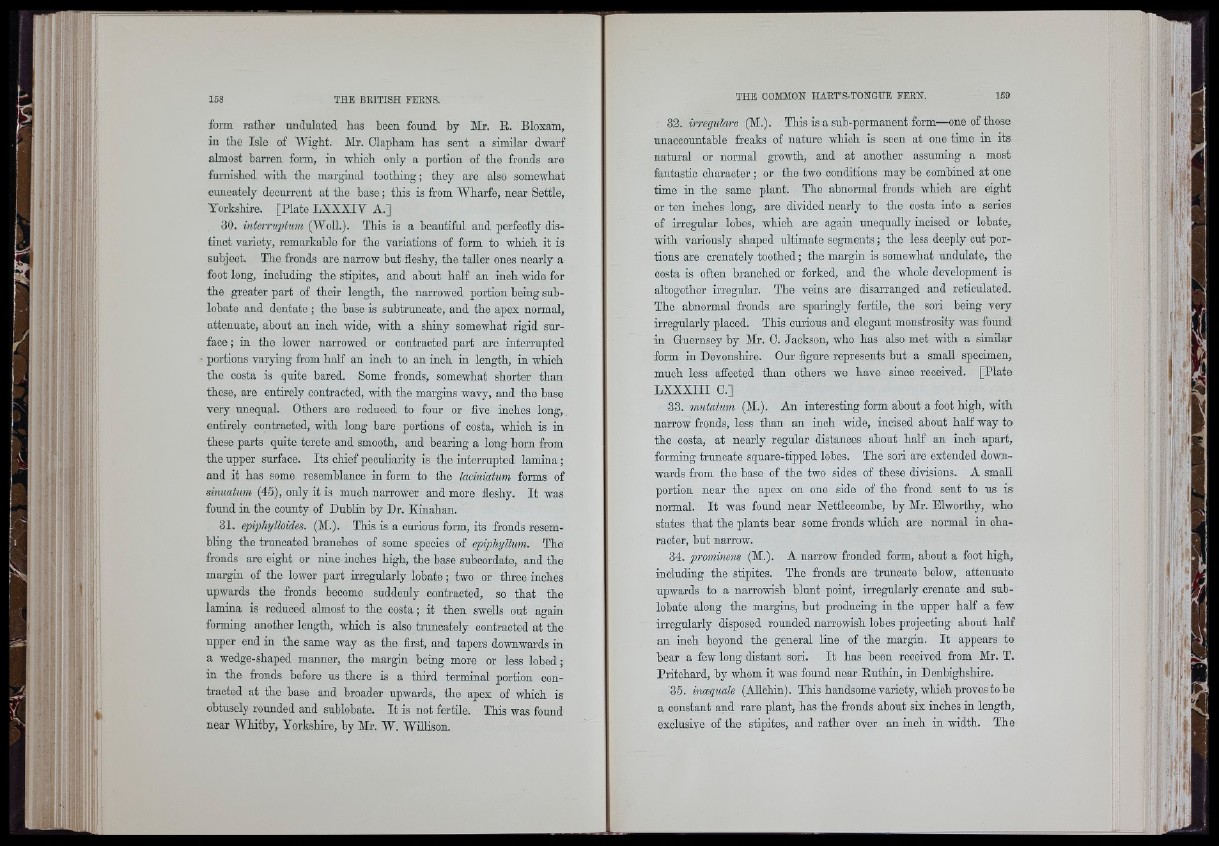
168
form rather undulated has been found by Mr. R. Bloxam,
in the Isle of Wight. Mr. Clapham has sent a similar dwarf
almost barren foim, in which only a portion of the fronds are
furnished with the marginal toothing; they aro also somewhat
cuneately deourrent at tho base; this is from AVharfe, near Settle,
Yorkshire. [Plato LXXXIV A.]
30. interruptum (Woll). This is a beautiful and perfectly distinct
variety, remarkable for the variations of form to which it is
subject. The fronds are narrow but fleshy, the taller ones nearly a
foot long, including the stipites, and about half an inch wide for
the greater part of their length, the narrowed portion being sublobate
and dentate; the base is subtruneate, and the apex normal,
attenuate, about an inch wide, with a shiny somewhat rigid surface
; in the lower narrowed or contracted part are interrupted
■ portions varying from half an inch to an inch in length, in which
the costa is quite bared. Some fronds, somewhat shorter than
these, are entirely contracted, with the margins wavy, and the base
very unequM. Others are reduced to four or five inches long,
entirely contracted, with long bare portions of costa, which is in.
these parts quite terete and smooth, and bearing a long horn from
tho upper surface. Its chief peculiarity is the interrupted lamina;
and it has some resemblance in form to the laciniatum forms of
sinuatum (45), only it is much narrower and more fleshy. It was
found in the county of Dublin by Dr. Kinahan.
31. epiphylloides. (M.). This is a curious form, its fronds resembling
the truncated branches of some species of epiphyllum. The
fronds are eight or nine inches high, the base subcordate, and tbe
margin of the lower part irregularly lohate; two or three inches
upwards the fronds become suddenly contracted, so that the
lamina is reduced almost to the costa; it then swells out again
forming another length, which is also truncately contracted at the
upper end in the same way as the first, and tapers downwards in
a wedge-shaped manner, the margin being more or less lobed;
in the fronds before us there is a third terminal portion contracted
at the base and broader upwards, the apex of which is
obtusely rounded and sublobate. It is not fertile. This was found
near Whitby, Yorkshire, by Mr. W. WiUison.
32. irreguläre (M.). This is a sub-permanent form—one of those
unaccountable freaks of nature which is seen at one time in its
natural or normal growth, and at another assuming a most
fantastic character ; or the two conditions may he combined at one
time in the same plant. The abnormal fronds which are eight
or ten inches long, are divided nearly to the costa into a series
of irregular lobes, which are again unequally incised or lohate,
with variously shaped ultimate segments; the less deeply cut portions
aro crenately toothed; the margin is somewhat undulate, the
costa is often branched or forked, and the whole development is
altogether irregular. The veins are disarranged and reticulated.
The abnormal fronds are sparingly fertile, the sori being very
irregularly placed. This curious and elegant monstrosity was found
in Guernsey by Mr. 0. Jackson, who has also met with a similar
form in Devonshire. Our figure represents but a small specimen,
much less affected than others we have since received. [Plate
LXXXIII C.]
33. mutatum (M.). An interesting form about a foot high, with
narrow fronds, less than an inch wide, incised about half way to
the costa, at nearly regular distances about half an inch apart,
formmg truncate square-tipped lohes. The sori are extended downwards
from the base of the two sides of these divisions. A small
portion near the apex on one side of the frond sent to us is
normal. It was found near Nettlecombe, by Mr. Elworthy, who
states that the plants hear some fronds which are normal in character,
hut narrow.
34. prominens (M.). A narrow fronded form, about a foot high,
including the stipites. The fronds are truncate below, attenuate
upwards to a narrowish blunt point, irregularly crenate and sublobate
along the margins, hut producing in the upper half a few
irregularly disposed rounded narrowish lobes projecting about half
an inch beyond the general line of the margin. It appears to
bear a few long distant sori. It has been received from Mr. T.
Pritchard, by whom it was found near Euthin, in Denbighshire.
35. inmquale (Allchin). This handsome variety, which proves to be
a constant and rare plant, has the fronds about six inches in length,
exclusive of the stipites, and rather over an inch in width. The
ir
II'
ri
)iii
*'L
'iri
(■‘I
li'!
fil